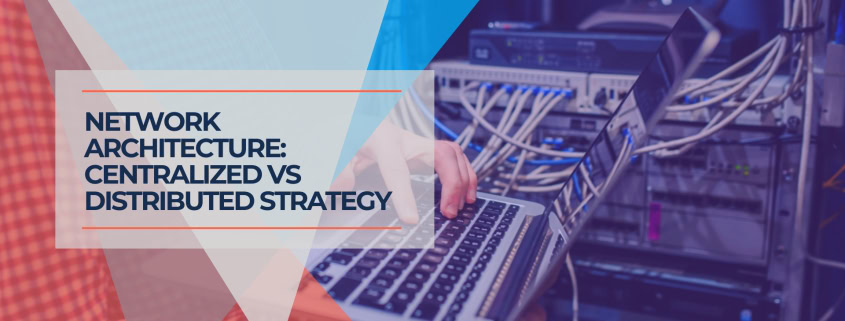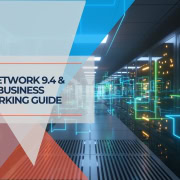Business Network Strategy: More Cables vs More Switches – The Critical Architecture Decision
Key Takeaway: The fundamental choice between centralized cabling (more cables) and distributed switching (more switches) significantly impacts both installation costs and long-term network management. This strategic decision should be made early in planning based on your building layout, operational requirements, and growth projections.
When planning business network infrastructure, most discussions focus on cable types, switch specifications, and wireless coverage. However, one of the most critical decisions often gets overlooked: Should you run individual cables from every connection point back to a central location or install fewer backbone cables and use distributed switches throughout your facility?
This architectural choice affects everything from initial installation costs to ongoing network management complexity. As businesses add more connected devices and expand their operations, understanding the implications of each approach helps you make informed decisions that align with your business needs, operational requirements, and budget constraints.
Table of Contents
- 1 The Two Primary Network Architectures
- 2 Business Application Scenarios
- 3 Cost Analysis Framework
- 4 Strategic Decision Framework
- 5 Hybrid Architecture Solutions
- 6 Implementation Best Practices
- 7 Frequently Asked Questions
- 7.0.1 How do I calculate the cost difference between centralized and distributed approaches?
- 7.0.2 What building size typically justifies distributed architecture?
- 7.0.3 How does network management complexity compare between approaches?
- 7.0.4 Can I start with one approach and migrate to another later?
- 7.0.5 What power and cooling requirements do distributed switches need?
- 7.0.6 How do security requirements affect the choice of architecture?
- 7.0.7 What's the typical performance difference between approaches?
- 7.0.8 How do expansion requirements affect the architecture decision?
- 7.0.9 What backup and redundancy considerations apply to each approach?
- 7.0.10 Should warehouse and industrial environments always use distributed switching?
- 8 Making the Strategic Architecture Decision
The Two Primary Network Architectures
Centralized Architecture: The “More Cables” Approach
In a centralized network architecture, every connection point throughout your facility connects directly back to a main network closet with a large central switch. This traditional approach treats the network like a hub-and-spoke system.
How It Works:
Every workstation, printer, wireless access point, and networked device has a dedicated cable running back to the main distribution frame (MDF). All network intelligence and management occurs at this central location, creating a single control point for the entire network infrastructure.
Key Advantages:
- Simplified network management: All configuration, monitoring, and troubleshooting happen from one central location
- Higher reliability: Fewer network devices mean fewer potential points of failure
- Centralized power requirements: Only the main network closet needs UPS backup power
- Easier security management: Network access control and monitoring from a single point
- Consistent performance: All connections have direct paths to core network resources
- Lower ongoing complexity: Reduces management overhead for smaller IT teams
Primary Limitations:
- Higher cable installation costs: Long cable runs to distant areas increase labor and material expenses
- Larger central switch requirements: Need high-port-count switches that can cost significantly more
- Complex cable management: The Main distribution frame can become crowded with numerous connections
- Distance limitations: Cable runs exceeding 100 meters need to be fiber
- Reduced flexibility: Adding connections requires new cable runs back to the central location
Distributed Architecture: The “More Switches” Approach
Distributed network architecture uses backbone cables to strategic locations and smaller switches to provide local connectivity. This approach brings network intelligence closer to end users and creates a more flexible, scalable infrastructure.
How It Works:
High-capacity backbone cables connect the main network closet to intermediate distribution frames (IDFs) throughout the facility. Local switches at each IDF serve nearby connection points, creating network zones that can operate semi-independently while maintaining centralized coordination.
Key Advantages:
- Lower cable installation costs: Fewer long cable runs reduce installation expenses
- Improved performance: Shorter cable runs and local switching improve network responsiveness
- Flexible expansion: Easy to add connections by expanding local switches
- Modular design: Network grows incrementally as business needs change
- Efficient for high-density areas: Serves many connections with minimal backbone infrastructure
- Better fault isolation: Problems in one area don't affect the entire network
Primary Limitations:
- Increased complexity: Multiple switches require more configuration and management
- Distributed power needs: Each switch location requires electrical power and potentially UPS backup
- Multiple failure points: Local switch failures can affect entire network segments
- Higher ongoing maintenance: More equipment locations need regular attention
- Network monitoring complexity: Requires tools to manage distributed infrastructure effectively
Business Application Scenarios
When Centralized Architecture Works Best
Small to Medium Offices (Under 10,000 sq ft)
Centralized architecture benefits buildings where all areas are within reasonable cable distance of a central location. The simplicity of management often outweighs the additional cable costs in smaller facilities. Consider our UniFi office network blueprint for optimized centralized designs.
High-Security Environments
Financial services, healthcare, and government facilities often prefer centralized architecture for security reasons. Having all network intelligence in one secure location simplifies compliance monitoring and reduces potential attack vectors.
Limited IT Resources
Centralized management benefits organizations with small IT teams. Troubleshooting network issues from one location reduces the expertise required and speeds problem resolution, making it ideal for businesses without dedicated network administrators.
Standard Office Layouts
Traditional office buildings with predictable layouts and standard density requirements work well with centralized approaches, especially when future expansion needs are well-defined and manageable.
When Distributed Architecture Makes Sense
Large Facilities and Campuses
Distributed architecture benefits buildings exceeding 15,000 square feet or multi-building campuses. The cost savings from reduced cable runs often justify the increased complexity of management. Our warehouse network wiring solutions demonstrate practical distributed approaches for large spaces.
High-Density Work Areas
Departments with 20+ workstations clustered together make ideal candidates for local switches. Call centers, engineering departments, and open office areas often fit this profile, where multi-gigabit network solutions can enhance performance.
Manufacturing and Industrial Environments
Facilities with distinct operational zones benefit from distributed switches. Each area can have local connectivity for inventory systems, workstations, and wireless access points while connecting to central resources via backbone connections.
Uncertain Growth Patterns
Organizations with unpredictable expansion needs benefit from the distributed architecture's flexibility. Local switches can be upgraded or added as requirements change without affecting the entire network infrastructure.
Real-World Implementation Example
Scenario: Two-story office building with 25 people per floor, concentrated in departmental clusters.
Centralized Approach: 50 individual cable runs to first-floor network closet, requiring 48-port switch and extensive cable management.
Distributed Approach: Two 24-port switches (one per floor) connected by backbone fiber, with local connections serving each floor.
Implementation Result: Distributed approach reduced installation costs by approximately 25% while providing better expansion flexibility and improved performance for future growth.
Cost Analysis Framework
Installation Cost Comparison
Current market data shows significant variation in installation costs based on approach selection. Understanding these cost factors helps you make informed budget decisions for your network infrastructure investment.
Centralized Architecture Costs:
- Cable materials: Higher total cable length for distant connections, particularly for Cat6A installations
- Installation labor: Additional time for long cable runs and complex routing through building infrastructure
- Central switching: High-port-count switches with advanced features can cost $3,000-$15,000 for business-class equipment
- Cable management: Extensive organization systems in the main closet, including patch panels and rack infrastructure
Distributed Architecture Costs:
- Backbone infrastructure: Fiber optic or high-capacity copper connections between locations
- Switch hardware: Multiple smaller switches versus one large switch, often resulting in lower per-port costs
- Power infrastructure: Electrical work at each switch location, including dedicated circuits
- Environmental considerations: Proper ventilation, cooling, and protection for distributed equipment
Use our structured cabling cost calculator to estimate costs for different architectural approaches based on your specific building requirements.
Technology Infrastructure Considerations
Power over Ethernet (PoE) Requirements
Modern business networks increasingly rely on PoE for wireless access points, security cameras, and VoIP phones. With Power over Ethernet requirements growing, consider how each architecture handles power distribution:
- Centralized PoE: All PoE power comes from the central switch, requiring higher-capacity power supplies
- Distributed PoE: Local switches can provide PoE closer to devices, reducing power loss over distance
- PoE+ and PoE++: Higher power requirements may favor distributed approaches for efficiency
Cable Infrastructure Planning
Your choice of Ethernet cables impacts both architecture approaches differently:
- Cat6 vs Cat6A considerations: Review our Cat6 vs Cat6A guide for performance and cost implications
- Distance limitations: Cat6 supports 10 Gigabit to 55 meters or 1 Gigabit to 100 meters, Cat6A supports 10 Gigabit to 100 meters
- Future upgrade planning: Consider bandwidth requirements for emerging technologies
Strategic Decision Framework
Evaluation Criteria
Use these criteria to evaluate which approach best fits your business needs and operational requirements:
Building Assessment:
- Total square footage: Facilities over 15,000 sq ft often favor distributed approaches
- Layout complexity: Multiple floors, wings, or buildings may benefit from local switches
- Construction type: New construction allows either approach; retrofits may favor distributed solutions
- Future expansion plans: Uncertain growth patterns favor distributed flexibility
- Cable pathway availability: Existing infrastructure may constrain centralized approaches
Operational Requirements:
- IT staff capabilities: Limited resources favor centralized management simplicity
- Security requirements: High-security environments often prefer centralized control
- Reliability needs: Critical applications may require redundant distributed switches
- Performance requirements: High-bandwidth applications may benefit from local switching
- Compliance obligations: Regulatory requirements may influence architecture choice
Financial Considerations:
- Initial budget constraints: The distributed approach may reduce upfront installation costs
- Operational budget: A Centralized approach typically reduces ongoing management costs
- Growth funding: Distributed architecture allows incremental investment over time
- Total cost of ownership: Consider 5-7 yearsof operational costs, including maintenance and upgrades
Quick Decision Guide
Choose Centralized Architecture When:
- Building under 10,000 sq ft with a straightforward, accessible layout
- Limited IT staff available for ongoing network management
- High security, compliance, or regulatory requirements
- Predictable, stable connectivity requirements with minimal growth expected
- Budget allows for larger central switching equipment investment
Choose Distributed Architecture When:
- Large facility, multiple buildings, or campus environment requiring extensive coverage
- High-density areas would require numerous long, expensive cable runs
- Future expansion requirements are uncertain, aggressive, or likely to be significant
- Building layout, age, or construction makes centralized cabling impractical or costly
- Performance benefits from local switching justify increased management complexity
Hybrid Architecture Solutions
Many successful business installations combine both approaches to optimize for specific needs, constraints, and operational requirements. Hybrid solutions often provide the best balance of cost, performance, and management complexity.
Zone-Based Hybrid Architecture
Use centralized cabling for standard office areas while implementing distributed switches for specific high-density zones or specialized applications.
Practical Applications:
- Call centers: Local switches serve agent clusters while management offices use centralized connections
- Engineering departments: High-performance local switches for CAD workstations and specialized equipment
- Conference facilities: Dedicated switches for meeting rooms, presentation equipment, and video conferencing systems
- Manufacturing areas: Industrial switches for production equipment separate from office network infrastructure
- Server rooms: Local high-speed switches for server connectivity while maintaining centralized management
Growth-Planned Hybrid Architecture
Install backbone infrastructure to support future distributed switches while initially using direct connections for immediate needs and budget optimization.
Implementation Benefits:
- Immediate cost savings: Start with a centralized approach for current connection requirements
- Built-in expansion capability: Backbone infrastructure ready for future switches and growth
- Incremental investment: Add distributed switches as budget and business needs develop
- Future-proofing: Pathway infrastructure accommodates changing technology requirements
- Risk mitigation: Avoid over-investing in uncertain future needs while maintaining flexibility
For comprehensive planning guidance, review our future-proof office network guide for strategic infrastructure planning approaches.
Building-Based Hybrid Architecture
Maintain centralized architecture within individual buildings using distributed switches for inter-building connections and remote locations.
Campus and Multi-Site Applications:
- Multi-building facilities: Each building maintains centralized switching with a fiber backbone between buildings
- Remote locations: Satellite offices connect via distributed switches over fiber or wireless backhaul
- Warehouse complexes: Central administration building with distributed switches in operational zones
- Educational campuses: Individual building networks connected through campus-wide backbone infrastructure
Implementation Best Practices
Planning Phase Considerations
Capacity Planning and Future Requirements:
- Current requirements analysis: Document existing device counts, bandwidth needs, and usage patterns
- Growth projections: Plan for 50-100% growth over a 5-year period based on business plans
- Application requirements: Consider bandwidth, latency, and reliability needs for critical business applications
- Technology evolution: Account for emerging technologies like IoT devices, high-definition video, and cloud applications
- Compliance requirements: Factor in industry-specific regulations affecting network design
Infrastructure Design Principles:
- Backbone capacity: Size backbone connections for peak usage plus projected growth requirements
- Redundancy planning: Design backup paths for critical network segments and services
- Power and cooling: Ensure adequate electrical infrastructure and environmental controls at all switch locations
- Physical security: Protect distributed equipment with appropriate enclosures and access controls
- Documentation standards: Establish comprehensive labeling and documentation procedures for future maintenance
Use our network cabling checklist to ensure all planning elements are properly addressed during the design phase.
Technology Selection Guidelines
Switch Selection Criteria:
- Port density optimization: Match switch sizes to actual connection requirements without significant over-provisioning
- Performance capabilities: Ensure adequate switching capacity and processing power for applications
- Management features: Select switches with appropriate monitoring, configuration, and troubleshooting tools
- Vendor consistency: Standardize on platforms for simplified management, training, and support
- Power efficiency: Consider energy consumption for ongoing operational cost management
Infrastructure Components:
- Backbone connections: Use fiber optic cables for long runs, high capacity, and future upgradeability
- Horizontal cabling: Cat6 adequate for most current applications; Cat6A for performance-critical or future-proofing requirements
- Cable management systems: Plan proper organization and protection for all connection points and pathways
- Testing and certification: Ensure all installations meet performance standards with proper documentation
For budget-conscious implementations, explore our budget 2.5 Gbps UniFi network solutions that balance performance and cost-effectiveness.
Frequently Asked Questions
How do I calculate the cost difference between centralized and distributed approaches?
Compare total installation costs, including cable materials, labor time, switch equipment, and electrical infrastructure work. For centralized approaches, calculate the cost of long cable runs and high-port-count switches. For distributed approaches, factor in multiple smaller switches, backbone infrastructure, and power requirements at each location. Include 5-year operational costs for management, maintenance, and potential equipment replacement to get the total cost of ownership.
What building size typically justifies distributed architecture?
Buildings over 15,000 square feet or facilities with concentrated high-density areas (20+ connections in one zone) often benefit from distributed switches. However, building layout and construction type matter more than total size. A narrow multi-story building might effectively use centralized architecture, while a sprawling single-story facility or campus environment typically needs distributed switching for optimal cost and performance.
How does network management complexity compare between approaches?
Centralized networks offer simpler troubleshooting and configuration management from one location, making them ideal for smaller IT teams. Distributed networks require network management tools to monitor multiple switches, coordinate configurations, and diagnose issues across locations. When choosing distributed architecture, plan for additional staff training, management software licenses, and documentation procedures, but benefit from better fault isolation and performance.
Can I start with one approach and migrate to another later?
Yes, but with significant planning considerations. Moving from centralized to distributed is generally easier by adding backbone infrastructure and local switches while maintaining existing connections. Moving from distributed to centralized requires running new cables back to central locations, which can be expensive and disruptive. Plan backbone pathways and conduit systems during initial installation to preserve future architectural flexibility.
What power and cooling requirements do distributed switches need?
Each distributed switch location typically needs adequate electrical power (one 15-20 amp dedicated circuit), proper ventilation or cooling, and potentially UPS backup power for critical applications. Plan for environmental controls in switch closets, especially in warehouse or industrial environments with extreme temperatures. PoE-enabled switches require additional power capacity, with PoE++ applications needing substantial electrical infrastructure.
How do security requirements affect the choice of architecture?
High-security environments often prefer centralized architecture for simplified monitoring, access control, and compliance management. However, distributed switches can provide valuable network segmentation benefits for security by isolating different business functions or departments. When making this decision, consider your compliance requirements, monitoring capabilities, physical security needs, and regulatory obligations.
What's the typical performance difference between approaches?
Distributed architecture often performs better due to shorter cable runs, reduced network congestion, and local switching that minimizes network hops. However, centralized architecture with properly sized switches and quality infrastructure can provide excellent performance for most business applications. When evaluating options, consider your specific bandwidth requirements, latency sensitivity, and application performance needs.
How do expansion requirements affect the architecture decision?
Distributed architecture provides significantly more flexibility for uncertain or aggressive growth patterns. You can easily add switch ports, upgrade local switches, or expand into new areas without affecting the entire network. Centralized architecture works well for predictable, measured growth but may require major infrastructure upgrades when connection requirements exceed central switch capacity or cable pathway limitations.
What backup and redundancy considerations apply to each approach?
Centralized architecture typically requires one large UPS system and creates a single point of failure, but simplifies backup planning. Distributed architecture may need multiple UPS units but provides better fault isolation, where problems in one area don't affect the entire network. Consider your uptime requirements, budget for backup systems, and business continuity needs when choosing your approach.
Should warehouse and industrial environments always use distributed switching?
Large warehouse facilities (over 25,000 square feet) typically benefit from distributed switches due to distances involved, zone-based operations, and environmental factors. However, smaller warehouses might work well with centralized architecture if the layout allows efficient cable routing. Consider your operational zones, device density, environmental conditions, expansion plans, and integration requirements with industrial systems when making this decision.
Making the Strategic Architecture Decision
The choice between centralized and distributed network architecture represents one of the most important early decisions in business network planning. This decision affects initial installation costs, long-term operational efficiency, expansion flexibility, management complexity, and overall business productivity.
Key Decision Factors:
- Building characteristics: Size, layout, construction type, and accessibility significantly influence the optimal approach
- Operational requirements: IT staff capabilities, security needs, compliance obligations, and reliability requirements
- Financial considerations: Both initial investment and ongoing operational costs over the equipment lifecycle
- Growth planning: Future expansion needs, uncertainty levels, and business development strategies
- Technology trends: Emerging requirements for IoT integration, cloud connectivity, and high-bandwidth applications
Implementation Success Strategies:
- Comprehensive cost analysis: Compare total 5-year costs including installation, equipment, operations, and maintenance
- Pilot implementations: Test distributed approaches in specific areas before full deployment
- Hybrid solutions: Combine approaches to optimize for specific business needs and operational requirements
- Future flexibility: Install backbone infrastructure and pathways to preserve future architectural options
- Professional consultation: Engage experienced network designers for complex environments or uncertain requirements
Neither approach is universally superior—the optimal choice depends on your specific business environment, operational requirements, and financial constraints. Careful evaluation using the frameworks provided in this guide and professional assessment of your infrastructure needs will help you make informed decisions that support current operations and future growth.
Understanding the benefits of proper network cabling infrastructure and implementing appropriate architecture decisions creates a foundation for business success in an increasingly connected world.
Professional network design expertise ensures your architecture decision aligns with your business goals while optimizing for cost, performance, and future flexibility. For additional guidance on implementing your chosen approach, explore our professional installation services to ensure proper implementation of your network infrastructure strategy.











Leave a Reply
Want to join the discussion?Feel free to contribute!